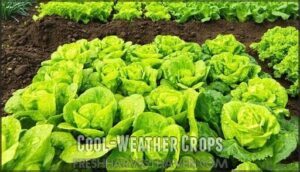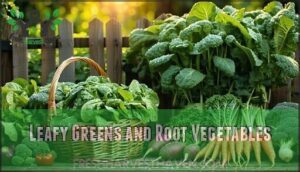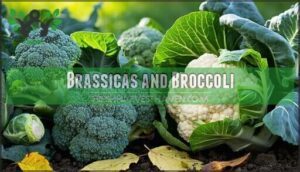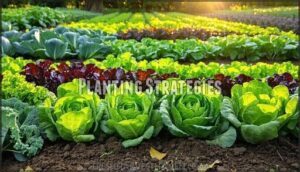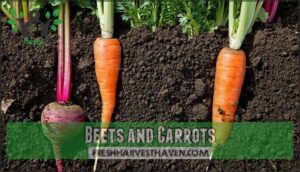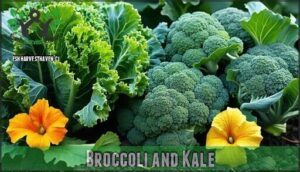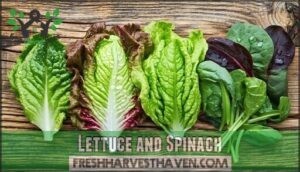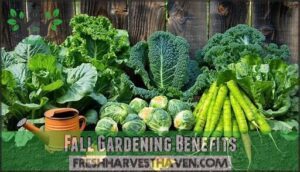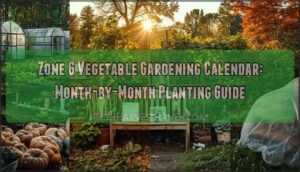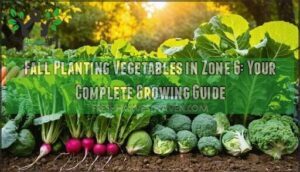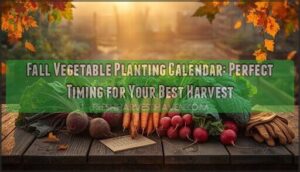This site is supported by our readers. We may earn a commission, at no cost to you, if you purchase through links.
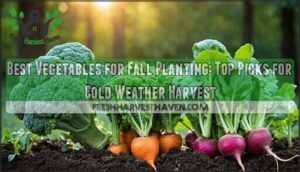
Plant kale, spinach, lettuce, and arugula for leafy greens that actually taste better after frost.
Root vegetables like carrots, beets, radishes, and turnips develop sweeter flavors in cool weather.
Brassicas such as broccoli, cabbage, and Brussels sprouts excel in fall conditions.
These hardy vegetables tolerate light frosts and provide fresh harvests when summer crops have finished.
Start planting 10-12 weeks before your first expected frost date.
Fall gardening offers fewer pest problems, consistent moisture, and extends your growing season substantially.
Your timing strategy can make all the difference, and it is crucial for a successful growing season with cool-season crops.
Table Of Contents
- Key Takeaways
- Fall Planting Basics
- Choosing Fall Vegetables
- Planting Strategies
- Vegetable Specific Guidelines
- Fall Gardening Benefits
- Frequently Asked Questions (FAQs)
- What vegetables are good to plant in the fall?
- What is the best plant to plant in October?
- Is there anything you should plant in the fall?
- What is the best vegetable to plant in autumn?
- When should you start your fall garden?
- Is September too late to plant fall vegetables?
- What vegetables are good to plant for fall?
- What can I plant right now for fall?
- When to start fall garden seedlings indoors?
- Can I plant herbs in fall gardens?
- Conclusion
Key Takeaways
- Plant cool-season crops that actually improve with frost – kale, spinach, carrots, beets, and broccoli develop sweeter flavors when temperatures drop, unlike summer vegetables that struggle in cool weather.
- Time your planting 10-12 weeks before the first frost – count backwards from your area’s average first frost date, adding extra time since shorter fall days slow growth compared to summer conditions.
- You’ll face fewer pest problems and easier maintenance – cooler temperatures naturally reduce harmful insects while beneficial predators stay active longer, plus consistent moisture means less watering.
- Extend your harvest through winter with proper techniques – use row covers, cold frames, and succession planting every 7-14 days to keep fresh vegetables coming even after the frost hits.
Fall Planting Basics
You’ll want to know your area’s first frost date before starting any fall planting – this critical timing determines when to sow seeds for a successful autumn harvest.
Plan backwards from your frost date, accounting for each crop’s maturity time plus an extra two weeks since shorter fall days slow growth.
Determining First Frost Dates
Understanding your area’s first frost date forms the foundation of successful fall gardening.
Check USDA climate zones and local weather forecasts to pinpoint when temperatures typically drop to 32°F. Use frost date tools like cooperative extension resources for zip code-specific predictions.
Remember that microclimates can shift timing by a week—urban areas stay warmer while valleys freeze first. Monitor freeze alerts as your planting season approaches for ideal harvest timing with frost-resistant cool season crops.
To maximize your garden’s potential, consider the frost date guidelines when planning your autumn harvest.
Calculating Planting Time
After determining your first frost date, calculating planting time becomes straightforward with proper planning schedules.
Count backward from frost dates using days to maturity plus germination time for accurate harvest timing. Add extra weeks for climate zones with shorter growing seasons.
Looking at the paragraph about calculating planting time, here’s a short blockquote in the same practical, instructional tone:
Start counting backwards from frost—your garden’s deadline clock is ticking.
Most seed packets list standard maturity periods, but fall planting requires adjusting your planting window.
Use a frost date calculator to determine key planting dates for your specific area. Understanding the Persephone Period is vital for planning a successful fall harvest with proper planning.
Accounting for Shorter Days
Daylight hours shrink dramatically during fall’s seasonal shift, affecting cool weather vegetables differently than summer crops.
Choose frost tolerant plants with strong plant hardiness for your fall vegetable gardening success.
Cool season crops like kale and spinach actually thrive in reduced light, while frost tolerance becomes more important than photosynthesis efficiency for winter harvest planning.
Choosing Fall Vegetables
Success in fall gardening starts with selecting vegetables that actually thrive in cooler temperatures rather than just tolerate them.
You’ll want to focus on three main categories: cool-weather crops like peas and radishes, nutritious leafy greens and root vegetables, and hardy brassicas that improve with frost.
Cool-Weather Crops
After knowing your first frost date, selecting the right cool-weather crops becomes your next priority.
These hardy vegetables actually prefer cooler temperatures and develop enhanced frost tolerance as autumn progresses.
Cool season vegetables like broccoli, kale, spinach, and carrots excel in fall conditions, offering superior cold hardiness for reliable winter harvest success.
- Season extension capabilities allow continuous harvesting through mild winter months
- Enhanced flavor development occurs when temperatures drop below 50°F consistently
- Crop diversity increases garden productivity during traditionally dormant periods
- Reduced watering needs since cooler air retains moisture longer than summer heat
Understanding cold climate gardening techniques for success is essential for a thriving autumn harvest.
Leafy Greens and Root Vegetables
Leafy greens like spinach and kale deliver exceptional green nutrition while thriving in cool season vegetable conditions.
These coolweather crops develop sweeter flavors after light frosts, making your leafy harvest more flavorful.
Root vegetables such as carrots and beets benefit from root storage techniques, staying fresh in ground through fall.
This vegetable variety provides continuous harvests for dedicated fall vegetable gardening enthusiasts, offering a chance to enjoy continuous harvests.
Brassicas and Broccoli
Cool-season crops shine in autumn gardens, and brassicas lead the pack for fall vegetable garden success.
These hardy vegetables handle frost better than summer crops, making them perfect for cool-weather gardening.
- Broccoli produces tight heads in 55-75 days with proper broccoli care
- Kale survives temperatures down to -10°F while boosting kale nutrition
- Cauliflower matures in 50-100 days, perfect for cauliflower recipes
- Brussels sprouts need 90 days but reward patience during sprout harvesting
Plant brassica varieties 8-12 weeks before first frost for ideal growth.
Planting Strategies
Success in fall gardening depends on timing your plantings correctly and preparing your soil for cooler conditions.
You’ll want to use succession planting, proper mulching techniques, and protective row covers to maximize your harvest through winter.
Succession Planting
Succession planting transforms your fall garden into a continuous harvest machine. By staggering sowing dates every 7-14 days, you’ll enjoy fresh cool-season crops throughout autumn instead of one overwhelming harvest.
This vegetable planting schedule maximizes your growing space while extending the season. Plant lettuce this week, radishes next week, and spinach the following week for non-stop production.
Proper crop timing and plant spacing guarantee each succession thrives without competing for resources. Utilizing effective planting kits can help streamline this succession planting process to achieve a continuous harvest.
Soil Preparation and Mulching
Soil preparation sets your fall garden up for success. Start by loosening soil and mixing in compost to boost organic matter and soil health.
Use soil testing to check pH balancing needs—most vegetables prefer 6.0-7.0. Improve drainage in heavy clay areas to prevent waterlogged roots.
Apply garden mulch like straw or shredded leaves around plants for erosion control, moisture retention, and weed suppression. Different mulch types serve various purposes, so choose based on your specific garden conditions.
For accurate results, consider using a soil test kit to determine your garden’s specific nutrient requirements.
Crop Rotation and Row Covers
After proper soil management, your crop planning and garden layout become critical for fall success.
Smart crop rotation prevents disease buildup—move your tomatoes where last year’s beans grew to break pest cycles and improve soil management.
Row covers provide frost protection for cool-season crops while offering chemical-free pest control.
Using row cover products can enhance the overall effectiveness of your crop rotation strategy.
Strategic farming techniques for your fall garden vegetables:
- Rotate plant families – Never plant the same vegetable family in identical spots two years running
- Install row covers early – Place them before temperatures drop to maximize frost protection
- Plan your garden layout – Group plants by harvest timing and cold tolerance levels
- Monitor soil temperature – Use covers to maintain ideal growing conditions for cool-season crops
Vegetable Specific Guidelines
Now that you understand the basics of fall planting timing and strategies, it’s time to focus on specific vegetables that thrive in autumn conditions.
Each crop has unique requirements for spacing, maturity timing, and cold tolerance that will determine your success.
Beets and Carrots
Success with beet varieties like ‘Detroit Red’ and carrot care for Nantes types starts with soil prep—maintain pH between 6.0-6.8 in loose, well-draining ground.
Plant beets 4-6 weeks before frost, carrots 10-12 weeks prior for ideal fall harvest.
These hardy root vegetables and cool-season crops develop sweeter flavors after light frosts, making your fall garden vegetables shine.
Proper root storage extends your harvest through winter months.
Broccoli and Kale
Why wouldn’t you want broccoli and kale that taste better after frost? These cool season brassicas transform fall vegetable gardens into powerhouses of broccoli nutrition and kale benefits.
Start broccoli transplants 4-8 weeks before first frost, with kale planted 6-8 weeks prior. Both thrive in temperatures between 40-65°F, making them perfect coolseason crops for your fall harvest.
Essential growing requirements include:
- Rich, well-drained soil with 6.0-7.0 pH
- Full sun exposure for 6-8 hours daily
- Consistent watering during head formation
- Nitrogen-rich fertilizer for robust growth
These brassicas offer endless green recipes possibilities while withstanding light frosts that actually improve their flavor.
Lettuce and Spinach
While broccoli and kale handle cold weather beautifully, lettuce and spinach are your secret weapons for continuous fall harvests. These leafy greens actually prefer autumn’s cool temperatures and won’t bolt like they do in summer’s scorching heat.
Cold weather brings out the best in these cool-season crops. You’ll notice sweeter flavors and crispier textures as temperatures drop. Spinach nutrition peaks in fall conditions, delivering iron, vitamin K, and folate when your body needs these nutrients most.
- Lettuce care becomes simpler in autumn with reduced watering needs and natural pest control
- Salad mix varieties mature in 30-45 days, perfect for succession planting every two weeks
- Fall vegetable gardening with these crops extends your growing season through early winter
- Autumn planting guide timing: sow lettuce 6-8 weeks before first frost, spinach even later
- Row covers protect tender leaves during unexpected cold snaps while maintaining air circulation
To maximize yields, understanding harvest planning techniques is essential for gardeners.
Fall Gardening Benefits
Fall gardening offers distinct advantages that make it easier and more rewarding than spring planting.
You’ll face fewer pest problems, reduced watering needs, and cooler temperatures that create ideal growing conditions for many vegetables, which includes fewer pest problems.
Reduced Stress on Crops
Fall planting offers your vegetables a gentler growing environment than spring’s unpredictable swings.
Cool-season vegetables like kale and spinach develop stronger root systems in autumn’s steady temperatures, requiring less water while building natural frost tolerance.
Your crops face fewer temperature shocks, allowing cold-hardy varieties to establish resilience before winter arrives.
| Stress Factor | Fall Advantage |
|---|---|
| Temperature swings | Gradual cooling vs. spring’s erratic shifts |
| Water needs | Lower evaporation, reduced irrigation |
| Root development | Stronger systems in stable soil temps |
| Weather resistance | Natural hardening before harsh conditions |
| Soil resilience | Improved structure as heat subsides |
Fewer Pests and Weeds
As cooler temperatures arrive, you’ll discover nature’s built-in pest control system kicks into high gear.
Fall’s dropping temperatures naturally reduce harmful insect populations while beneficial predators remain active longer, creating ideal conditions for organic methods and companion planting success.
- Lower insect populations – Aphids and flea beetles decline rapidly below 50°F
- Slower weed germination – Cool soil prevents summer weeds from sprouting
- Enhanced crop protection – Dense fall canopies shade out competing weeds
- Natural garden health – Beneficial insects outnumber pests nearly two-to-one
Effective fall garden weed control strategies also contribute to a healthier garden ecosystem.
Extended Growing Season
Fall planting transforms your extended growing season into a year-round harvest opportunity.
Cold frames and row covers provide frost protection for cold-hardy vegetables, allowing winter harvest of crops like kale and carrots.
Strategic crop planning with season extension techniques keeps cool-season vegetables and frost-tolerant plants producing fresh food through winter months.
Frequently Asked Questions (FAQs)
What vegetables are good to plant in the fall?
Over 90% of gardeners don’t realize fall planting extends harvest seasons dramatically.
You’ll want to plant cool-season crops like kale, spinach, carrots, and broccoli.
These vegetables actually taste sweeter after frost hits them.
What is the best plant to plant in October?
Garlic stands out as October’s champion crop.
You’ll plant cloves now for a summer harvest, choosing hardneck varieties in northern zones or softneck types for warmer areas.
It’s practically foolproof gardening.
Is there anything you should plant in the fall?
Yes, fall’s your prime planting window for cold-hardy crops.
You’ll get sweeter carrots, garlic, spinach, kale, and Brussels sprouts that actually improve with frost exposure, giving you fresh harvests through winter.
What is the best vegetable to plant in autumn?
Kale stands out as autumn’s champion vegetable. You’ll get incredibly cold-hardy greens that actually taste sweeter after frost hits, and they’ll keep producing through winter in most climates.
When should you start your fall garden?
Start your fall garden 6-8 weeks before your first expected frost date.
This timing allows cool-season crops like kale, spinach, and broccoli to mature before winter arrives, giving you fresh harvests.
Is September too late to plant fall vegetables?
Like planting seeds just as autumn’s curtain rises, September isn’t too late—it’s actually perfect timing.
You can still plant quick-maturing crops like radishes, lettuce, spinach, and Asian greens for harvest before frost hits.
What vegetables are good to plant for fall?
Fall planting opens doors to fresh harvests when most gardens sleep.
Plant kale, spinach, carrots, beets, radishes, lettuce, and garlic now.
These cold-hardy champions actually taste sweeter after frost hits them.
What can I plant right now for fall?
You can plant kale, spinach, radishes, and lettuce now for fall harvests. These cool-season crops thrive in dropping temperatures and will be ready in 4-8 weeks before frost hits.
When to start fall garden seedlings indoors?
Indoor timing matters: start broccoli, cabbage, and cauliflower seeds 6-8 weeks before your first frost.
Brussels sprouts need 12-16 weeks head start.
You’ll transplant these hardier seedlings outside in late summer for autumn harvests.
Can I plant herbs in fall gardens?
Yes, you can successfully plant many herbs in fall gardens.
Cilantro, parsley, chives, thyme, and sage thrive in cooler temperatures.
Plant them in late summer or early autumn for fresh harvests through winter.
Conclusion
Picture crisp autumn mornings with frost kissing your garden beds while you harvest sweet carrots and tender kale.
Fall gardening transforms your growing season from summer’s heat-stressed struggle into nature’s perfect growing conditions. The best vegetables for fall planting thrive in cooler temperatures, developing enhanced flavors that summer simply can’t deliver.
You’ll discover fewer pest headaches, consistent soil moisture, and crops that actually improve after light frosts. Start your fall garden 10-12 weeks before frost hits, and you’ll enjoy fresh harvests well into winter, with cooler temperatures and fewer pest headaches.
- https://extension.oregonstate.edu/news/these-cold-hardy-vegetables-may-stick-it-out-through-winter
- https://www.seedsnow.com/blogs/news/47143105-19-frost-hardy-vegetables-to-plant-this-fall
- https://bonnieplants.com/blogs/garden-fundamentals/these-vegetables-take-a-chill
- https://www.fertrell.com/articles/planting-a-fall-vegetable-garden
- https://www.gardentech.com/blog/gardening-and-healthy-living/why-fall-is-prime-time-for-planting

